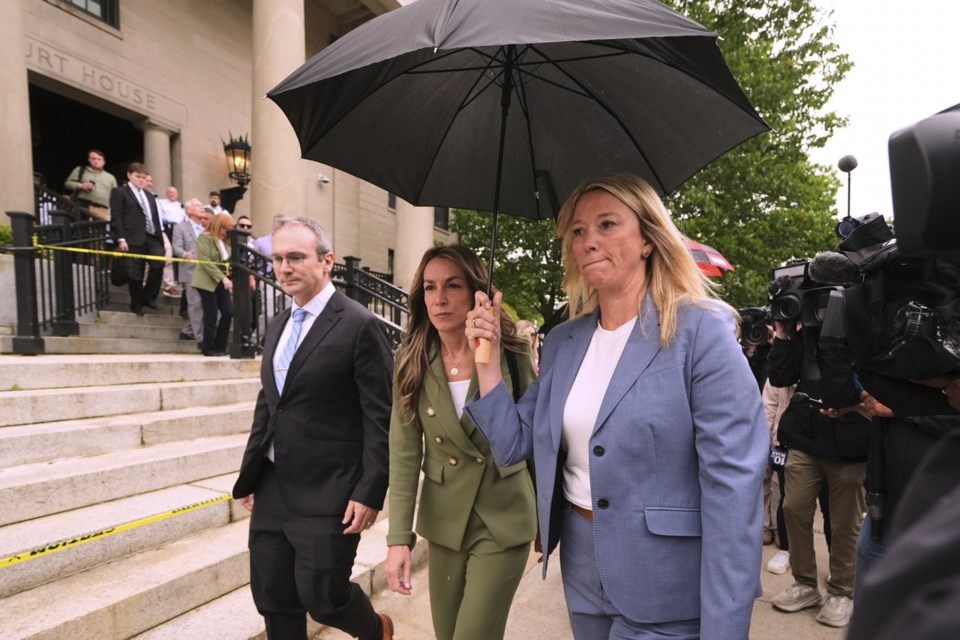DEDHAM, Mass. (AP) — The jury asked the judge several questions relating to charges and evidence Tuesday in the second murder trial of Karen Read, who is charged with killing her Boston police officer boyfriend.
Jurors began deliberations late last week, more than a month after the trial started. The second full day of deliberations began Tuesday morning and ended without a verdict. More deliberations are scheduled Wednesday.
Read, 45, is accused of striking John O’Keefe with her car outside a suburban Boston house party and leaving him to die in the snow in January 2022. She has been charged with second-degree murder, manslaughter and leaving the scene.
Read's lawyers say O’Keefe, 46, was beaten, bitten by a dog and then left outside a home in Canton in a conspiracy orchestrated by police that included planting evidence against Read.
Read's second trial followed similar contours to the first, which ended in a mistrial last year.
Jury asks judge to clarify evidence, charges
The jury asked questions of Judge Beverly Cannone, who also oversaw the first trial. Both sides discussed the questions in open court.
The first question related to the time frame of an operating a motor vehicle under the influence charge. Prosecutors wanted Cannone to instruct the jury to consider a time of 12:45 a.m., while the defense didn’t want a time specified. The defense argued during the trial that Read returned home and kept drinking, which would have influenced her blood alcohol level. Cannone said she would advise jurors that they are the finders of fact and to make their own decision based on the evidence.
On the second question, the jury asked whether video clips of interviews Read did in a documentary that were presented at trial constituted evidence. The judge said they were.
The third question pertained to the jury slip, specifically whether a guilty verdict on a lesser charge of driving under the influence meant guilt on the main charge, which is manslaughter while operating a motor vehicle under the influence. The defense argued that amendments should be made in the jury slip to make it clearer.
Cannone returned to the courtroom with the jury present and answered the three questions, emphasizing that this was their case to decide. “You folks have all the evidence. It’s only you who decides the facts in this case. You are the fact finders,” she said.
She then turned to the second question, saying they should treat Read’s interviews as evidence. “Yes, videos are evidence. You should weigh the defendant’s statements in the video interviews as you would any other piece of evidence and give them the weight you deem appropriate,” she said.
Cannone then went through the amended jury slip with jurors before releasing them to continue their deliberations.
Daniel Medwed, a law professor at Northeastern University who is not involved in the case, said it's “quite possible it is heading for a compromise or mercy verdict, a split verdict,” in light of the questions.
“My take is that the jury might be homing in the OUI charge, suggesting they might have doubts about whether she struck him at all,” Medwed said.
After a break, the jury returned a fourth question to Cannone, asking if they found Read not guilty on two charges but couldn’t agree on the third charge, would it be a hung jury on all three charges? Cannone said she would respond to the jury that the question was theoretical and not one she could answer.
The defense has said several jurors from the first trial came forward and said the jury was set to acquit Read on two charges but deadlocked on a third, leading to the mistrial.
Defense and prosecution paint different pictures of O'Keefe's death
Defense attorney Alan Jackson began his closing argument Friday by repeating three times: “There was no collision.” He told the jury that Read is an innocent woman victimized by a police cover-up in which officers sought to protect their own and obscure the real killer.
Prosecutor Hank Brennan opened his own closing by saying Read callously decided to leave O’Keefe dying in the snow, fully aware that he was gravely injured. He argued that she made the “choice to let” himdie, going further than prosecutors in the first trial in spelling out a motive.
Jackson repeatedly attacked the lead investigator in the case, former Massachusetts State Trooper Michael Proctor, who was fired after sharing offensive and sexist texts about Read with friends, family and co-workers. He said Proctor's “blatant bias” tainted every aspect of a corrupt and flawed investigation and noted how prosecutors refused to put him on the stand, as they did during the first trial.
Brennan said Read's blood alcohol level was two to three times the legal limit after the couple downed multiple drinks at two Canton bars. The couple, whose “toxic” relationship was “crumbling,” had an argument on the way to the house party that increased tensions and ultimately led to O'Keefe's death, the prosecutor said.
“She was drunk, she hit him and she left him to die,” Brennan said.
What are the charges Read faces?
Read faces several charges, the most serious being second-degree murder. If convicted she would face a maximum sentence of life in prison. She also faces a charge of manslaughter while operating a motor vehicle under the influence, which carries a maximum of 20 years.
She is also charged with involuntary manslaughter, which carries a maximum of 20 years; motor vehicle homicide, which carries a maximum of 15 years; as well as operating under the influence and leaving the scene of an accident resulting in death. They carry maximum sentences of 2 1/2 and 15 years, respectively.
___
Whittle reported from Scarborough, Maine.
Michael Casey And Patrick Whittle, The Associated Press




